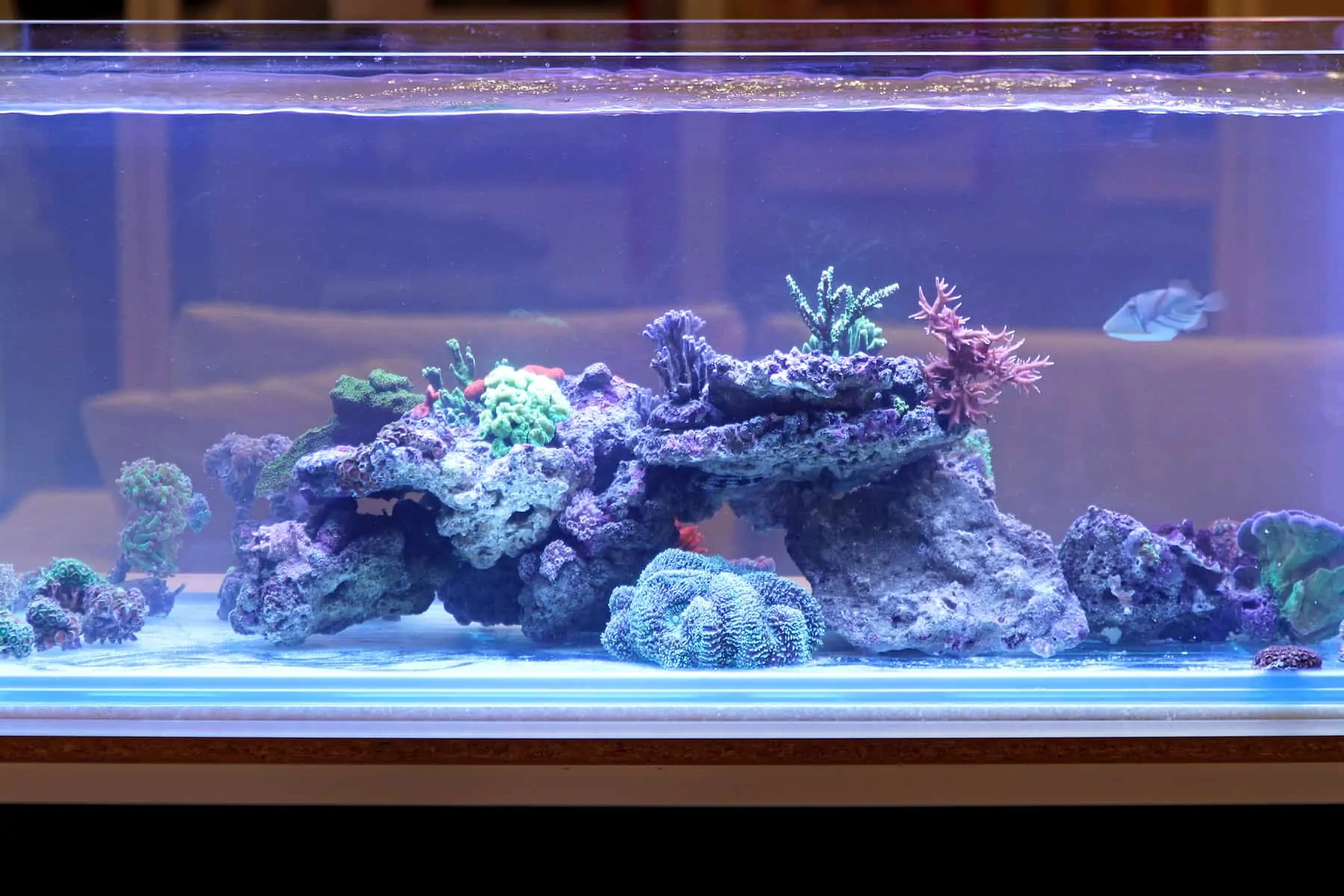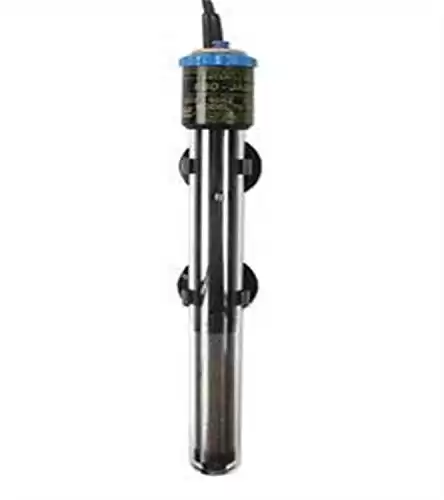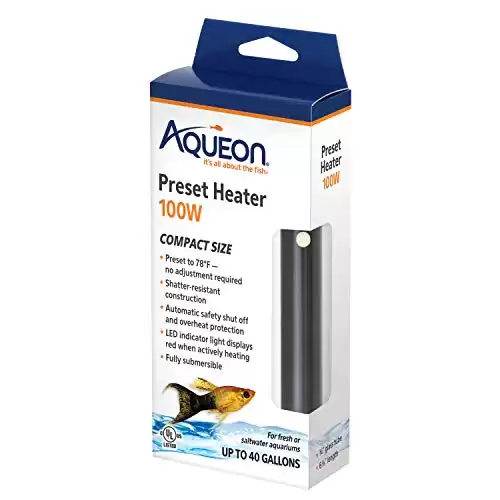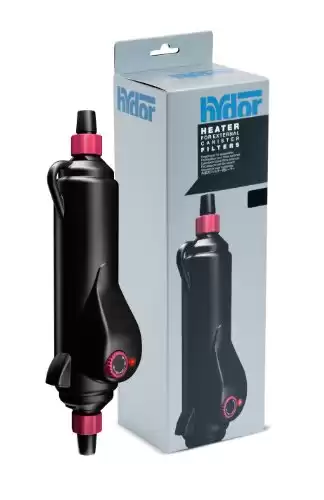One of the most important pieces of equipment you will buy for your aquarium is a heater. From my own experience and from the horror stories of others in the hobby, it is most definitely worth it to spend a little more on a reliable heater than to find a frozen or boiling tank waiting for you! However, this doesn’t necessarily mean that quality needs to be expensive! We have chosen five of our favorite aquarium heaters based on quality, expense, and on both customer and personal reviews.
Keep reading for everything you need to know about aquarium heaters: why you need them, how they work, and which heater is the best for your fish tank.
|
4.5
|
4.4
|
4.5
|
Why do you need an aquarium heater?
If you’re keeping tropical fish, whether freshwater or saltwater, you’re going to need to keep the tank water at tropical temperatures. Most of the fish you’re used to seeing in aquarium stores are mostly from the warm waters of South America and Asia where the temperature remains pretty constant between 72-82° F (22-27.7° C) all year round. This temperature range is optimal and allows for most of your fish, invertebrates, plants, and corals to thrive.
Irregularly heating your aquarium from time-to-time is not enough, the temperature needs to be stable and constant; fast fluctuations in temperature can quickly stress out or kill fish and plants and will make coral bleach. A good aquarium heater will keep your aquarium water at an ideal temperature, turning on once this temperature falls and turning off once it has been reached.
An aquarium heater can also be used to help treat fish with diseases and parasites. Most commonly, hobbyists will experience ich (Ichthyophthirius multifiliis), also known as white spot disease, sometime in the life of the their tank. One of the best ways to combat ich is by raising the water temperature because the parasite has difficulty reproducing at higher temperatures, leading to healthy fish in less time.
In these cases, the best aquarium heater would need to be adjustable so that you could slowly change the water temperature over the course of a couple of days. We will discuss the advantages of submersible and in-line heaters as well as adjustable vs preset temperature dials.
Types of aquarium heaters
Over the last few decades, there have been a few different phases of popular aquarium heaters, like with substrate heaters and in-line heaters. Today, you are most likely to see a fully submersible heater in any given aquarium or sump.
Substrate heaters
Substrate heaters used to be very popular in the hobby, but they were very expensive, inconvenient, and did not yield the best results. These fully submersible heaters would sit under the substrate with the belief being that the substrate would warm up and stay warm while heating the tank in a less obtrusive way. It was also believed that while this heat rose, it would also carry out unwanted nutrients from the substrate so new nutrients could settle instead; we now know that ample water flow will do just the same.
Substrate heaters also make it very difficult to add live plants; their roots often became tangled and lead to problems. That being said, if ever there was a problem with your substrate heater, you would need to dig it up and disturb the substrate. As we now know, anaerobic pockets are created in compact and settled substrates. Once these areas are disturbed, the gases are released into the water and can lead to a quick death for all your fish, invertebrates, and possibly plants.
There are not too many benefits to having a substrate heater, but you will still see them for sale and some hobbyists may still have theirs running from years ago.
In-line heaters
If you’re really looking to DIY your entire aquarium, then an in-line heater may be something you’re considering. These heaters warm water as it travels from the external filtration (sump/canister filter) back into your tank via the plumbing tubes. Assembly takes a little more time with added plumbing consideration and planning, but these heaters seem to do good for tanks with aggressive fish and/or limited space for equipment.
However, in-line heaters tend to be more expensive than most readily available submersible heaters and are more prone to leakage.
Submersible heaters
The most widely available and used type of heater is the submersible aquarium heater. These easy to use heaters are usually attached to the side of glass by suction cups and have an indicator light for when the heating element turns on. You also have the choice of placing your submersible heater directly in your main display or out of sight in your filter or sump.
There are some heaters that cannot be fully immersed but the packaging should make it clear, though most products available today are fully submersible.
There are also two different kinds of submersible heaters you need to consider for your tank: adjustable and preset.
Adjustable vs. preset
If you’ve decided on warming your fish tank with a submersible aquarium heater, you have to decide if you need an adjustable or preset one. An adjustable aquarium heater lets you set the desired temperature whereas the preset is set to a fixed temperature that cannot be changed.
In most occasions, you always wanted to get an adjustable submersible aquarium heater. However, many tropical fish starter kits include a preset heater and it may be all you have to work with for the first few months of having your aquarium. If you plan on keeping your tank for a while, it is definitely recommended to upgrade for more control and accuracy.
However, it can be a little more challenging to find an adjustable submersible aquarium heater for smaller tanks and a preset one may be the only one you can find in a hurry. Luckily, there are some preset heaters that work just as well as some adjustable ones!

What size heater do you need for your fish tank?
Getting the right-sized fish tank heater is very important. Too small of a heater can lead to cold water or even overwork itself to the point that it overheats the tank. Too big of a heater may not even fit correctly in your tank and will have to turn on and off more often since it will warm the water quicker.
The amount of heat that an aquarium heater generates is measured in watts. Each aquarium heater is usually rated with different watts needed for different amounts of water; the general rule is 2.5 to 5 watts per gallon. However, this largely depends on room temperature and what you plan on keeping in the tank.
You should figure the average temperature range of the room that your tank will be in across all four seasons. Your fish tank heater should especially be able to keep up working correctly when room temperature drops significantly.
Where should my aquarium heater be placed?
When it comes to buying a submersible aquarium heater, there are two main possibilities of placement: in your main display or in your sump. Many hobbyists like having a clean look to their aquarium, and a submersible heater tends to distract from the overall appearance of the tank. This is why many people find that the best place to put their heater is with the rest of their equipment.
If you choose to put your heater in your sump, it should be in an area with enough flow and where it will remain completely submerged all the time; make sure that your heater will fit in your sump beforehand! If your heater is taller than the water line in your sump, then you can also use the suction cups to lay it horizontally.
If you are fine with seeing your heater in your tank, then it will also do best in areas of high flow. This way, the warm water will be evenly distributed throughout the entire tank, reaching a uniform desired temperature.
How long do aquarium heaters last?
One of the biggest problems your fish tank can run into is a faulty aquarium heater. By the time you’ve figured out that your aquarium heater isn’t working properly, it’s usually too late.
How long your aquarium heater lasts depends largely on the manufacturer and condition that you keep it in, but heaters are known to spontaneously combust regardless. Some aquarium heaters come with warranties that make them easy to replace. In my own experience, it is always good to have an extra aquarium heater on hand just in case my main one breaks and also to help match the water temperature during water changes!
It is best to get a heater with an LED light that you can watch turn on and off and track the temperature range with your thermometer.
Our five best aquarium heaters
We’ve chosen five of our favorite aquarium heaters, with some being fully submersible, adjustable, preset, and/or in-line. We have based these choices on customer reviews as well as from personal experience to compile the best aquarium heaters currently available that will make your fish tank thrive for years!
Eheim Jager Aquarium Thermostat Heater
One of the best known international aquarium brands you’re bound to come across is Eheim. They offer the Eheim Jager Aquarium Thermostat Heater which are clear glass heaters that are shatterproof to withstand bumps from aquarium decorations and fish alike.
Temperature can be manually adjusted between 65° and 93° F (18° and 34° C) and has an accuracy of +/- 0.5° C. The Eheim Jager will need to be calibrated upon first use and regularly afterward for best operation; however, this process can be tricky and many have said that the heater did not warm the water to the exact calibrated number.
The Eheim Jager heater is fully submersible and features an LED light that lets you know when it comes on in your tank. It will also automatically shut off if the water level gets too low to prevent it from running dry. This model comes with an extra-long power cord for easy connection to an outlet, mounting bracket, and suction cups.
You can also read our in-depth review of the Eheim Jager Aquarium Thermostat Heater here.
What we like:
- Great accuracy and large temperature range
- Shatterproof glass
- Ability to recalibrate to ensure the desired temperature
- Fully submersible
- Indicator light
- Shuts off when the water level drops
Room for improvement:
- Tricky to calibrate and sometimes inaccurate
- Tends to be longer than other aquarium heaters
Cobalt Aquatics Flat Neo-Therm Heater with Adjustable Thermostat (Fully-Submersible, Shatterproof Design) from 25W to 300W
The Cobalt Aquatics Flat Neo-Therm Heater with Adjustable Thermostat looks very different from your typical glass aquarium heater. The sleek and thin shatterproof design of this heater allows for easy and unobtrusive placement in the aquarium.
The fully submersible Cobalt Aquatics heater features a one-touch activation for temperatures between 66 to 96° F (19 to 35.5° C) with +/- 0.5° F accuracy. The LED interface simultaneously displays both the programmed temperature and the actual temperature reading of the tank. The Cobalt Aquatics heater will also shut down to prevent overheating.
This heater comes with a reversible holster/bracket for inward- or outward-facing placement and also includes a 3-year warranty.
What we like:
- Large temperature range and great accuracy
- Sleek and shatterproof
- Fully submersible
- Easy to read and easy to use
Room for improvement:
- Expensive
- Was known to have previous faulty models
- Cannot be calibrated
Aqueon Adjustable Pro Aquarium Heater
- Adjustable heat setting 68 to 88°F, Electronic Thermostat accurate to +/- 1°
- Shatterproof and nearly indestructible
- Fully submersible; Auto Shut-Off when over-heats, resets when it cools down
Simple and accurate, the Aqueon Adjustable Pro Aquarium Heater is among the best aquarium heaters available right now. This heater only has a temperature range between 68 and 88° F (20 and 31° C) with an accuracy of +/- 1° F but is known to stay within that desired range.
This completely submersible aquarium heater is shatterproof and all-black for an understated addition to any aquarium or sump. The indicator light turns red when the heater comes on and green when it is off for convenience. The Aqueon Pro heater also automatically shuts off to prevent overheating and has a limited lifetime guarantee.
What we like:
- Inexpensive for proven accuracy
- Shatterproof and uniform color
- Easy to read indicator light
- Limited lifetime guarantee
Room for improvement:
- Limited temperature range
- Less exact accuracy
- Short lifespan
Aqueon Preset Heater
Perhaps you’ve picked up your first fish tank kit and a preset heater came with it. While you should always look to upgrade to an adjustable heater, like the Aqueon Pro, the Aqueon Preset Heater will fit the needs of most beginners for the time being. A preset heater can also be used as a back-up heater or for matching the temperature during water changes.
The Aqueon Preset Heater is set to an ideal temperature of 78° F (25.5° C), though this heater has been known to make water temperature fluctuate and go above or below that average temperature. This heater can be completely submerged under the water and is shatter-resistant. It features an LED indicator that comes on when the heater is on. Like the Aqueon Pro, the Aqueon Preset will automatically shut off if it starts to overheat. A 1-year warranty is also included.
What we like:
- Good emergency heater and/or heater for water changes
- Set to an ideal temperature
- Easy to read light indicator
Room for improvement:
- Only shatter-resistant, not fully shatterproof
- Cannot change the temperature
- Not the most accurate or dependable heater
Hydor In-Line External Heater – Original ETH
- Suitable for marine and tropical aquariums
- Easy to use
- High precision electronic temperature control
If you have a sump tank or canister filter below your aquarium, then you may be considering freeing up some space by using an in-line heater. The Hydor In-Line External Heater – Original ETH is one of the best aquarium heaters out there that fits your needs.
A spin dial is used to manually select the desired water temperature for the tank. The water that is being returned from your sump tank or canister filter is then passed through the Hydor In-Line External Heater, where it is electronically warmed with precision to meet the ideal temperature.
This heater needs to be secured and in a vertical position to work its best. Some claim that their heater will make clicking noises from time to time but that overall, there is no reduction in return flow to the tank. Any additional plumbing outside of the tank always increases the chance of leakage, so be sure to get tight seals.
What we like:
- Clears up space in the main fish tank
- Compatible with sumps and canister filters
- No noticeable return flow reduction
Room for improvement:
- Could include more needed plumbing parts
- Dial is a little difficult to read
- Needs to be as close to vertical as possible
- More expensive than a traditional heater
What if my tank stays warm enough without a heater?
If you are in a tropical area where temperatures don’t fluctuate, you may still want to purchase an aquarium heater for extra security. Even if your tank manages to stay at an ideal temperature throughout most of the day, fish, corals, plants, and invertebrates do best in consistent conditions.
While some hobbyists have had success keeping tropical fish tanks without a heater, many like to have a back up just in case the temperature suddenly falls. Now if you’re in an area that has constantly high temperatures that exceed the optimal temperature for fish, then you may want to consider using a chiller or placing fans above your tank.
Chillers and fans
Aquarium chillers do just that: chill your aquarium. It is important to keep your aquarium temperature at an optimal level because higher temperatures mean lower oxygen levels, making it difficult for fish and other livestock to properly breathe.
Many hobbyists who live in tropical climates or places that get hot summers often find it best to monitor the temperature in their tank with a chiller for a couple of weeks or months. The mechanics behind chillers are a lot more complicated than heaters and the machines are also much larger.
However, if you only find the temperature of your tank rising only a few more degrees past optimal, you may be able to get by without installing a chiller. One easy alternative to lowering the temperature of your tank is by adding fans to the top of the aquarium. This will help increase evaporative cooling, lowering the temperature by about 3-4° F.
Again, consider the highest temperature and lowest temperature your tank will be exposed to before completely setting it up. You may need just an aquarium heater or just an aquarium chiller, or maybe you will need both!
Here are a few other methods you could also try to lower the temperature in your tank.
Conclusion
No aquarium heater can be fully trusted, but you can make every effort to get a reputable and dependable brand that is least likely to fail.
I have had some experience with the Aqueon Preset heater due to it being included in an all-in-one kit. For the most part, it has been very reliable but I plan on upgrading to the Aqueon Adjustable Pro Aquarium Heater soon for my 10 gallon (37.8 L) saltwater reef tank.
No matter which heater you choose, always keep an eye on the temperature of your tank; I try to check mine at least twice a day. Sadly, it’s not a matter of if the heating element of your heater will break, but when it will. Getting a good heater from the start will help prevent a lot of problems!
If you have any questions about aquarium heaters, the ideal temperature for your tank, or have success with a certain brand or type of heater, don’t hesitate to leave a comment below!










